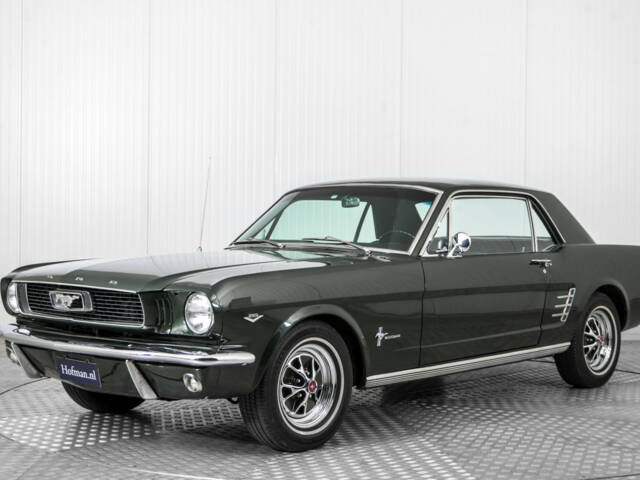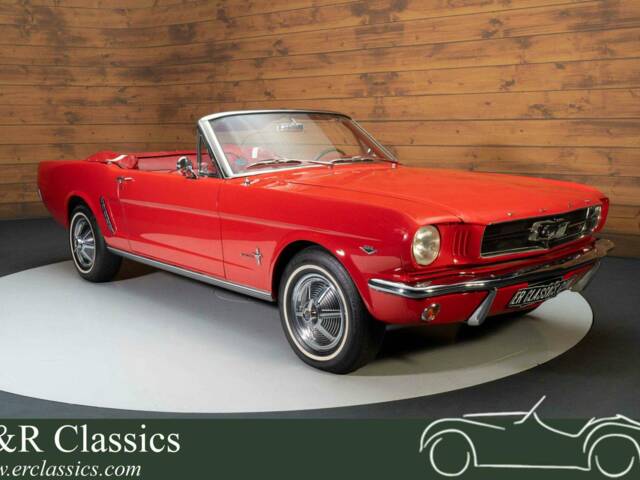Ford Mustang Classic Cars for Sale
The classic Ford Mustang is not just a car; it's a legend. Since its introduction in 1964, it has symbolized freedom and American engineering prowess. The Mustang pioneered the Pony Car category—compact, affordable sports cars accessible to a broad audience. With its aggressive design, powerful engines, and unforgettable appearances in pop culture, the Ford Mustang has carved a unique niche in automotive history. Learn more about its origin, the most famous models, and what to consider when buying a classic Ford Mustang.
Search results

1968 | Ford Mustang 289
technisch solider "muscle car" zum fahren und Spaß haben

1965 | Ford Mustang 289
Ein Rassepferd in seltener Kombination: Dieser tadellose Mustang namens "Dolly" überzeugt mit Kraft, Ästhetik und Geschichte.

1966 | Ford Mustang 289
Ford Mustang Convertible


1966 | Ford Mustang 289
Automatic TÜV/H 11-2025

1966 | Ford Shelby GT 350
Rekonstruktion eines legendären Sportwagens - der GT350R Replica.

1969 | Ford Mustang Mach 1
Ford Mustang MACH ONE JOHN WICK LOOK BIGBLOCK

1967 | Ford Mustang 390
Ford Mustang Fastback s-code 390

1969 | Ford Mustang Mach 1
Ford Mustang MACH ONE S-CODE 390

1966 | Ford Mustang 289
Ford Mustang Fastback K-code GT

1966 | Ford Mustang 289
Ford Mustang V8 automaat

1994 | Ford Mustang GT
Ford Mustang GT | 70.838 Km | Europese auto | 1994

1965 | Ford Mustang 289
Ford Mustang Cabriolet | Gerestaureerd | 1965

1965 | Ford Mustang 200
Ford Mustang Cabrio | Gerestaureerd | Prairie Bronze | 1965

1965 | Ford Mustang 289
Colour Ivy green combined with an Ivy and Gold leathercloth ‘pony’ interior
Classic Ford Mustang: History
The story of the classic Ford Mustang began in 1964 when the first model was unveiled at the New York World's Fair. Under the leadership of Lee Iacocca, Ford created a vehicle that would establish a new segment in the automotive market: the Pony Car. The Mustang was designed to fill the gap between compact sedans and sports cars and was an immediate commercial success. Within the first 18 months, over a million Mustangs were sold.
The design of the Mustang, featuring a long hood and short rear end, set new standards and quickly became iconic. While early models were characterized by lighter engine options, Ford developed powerful V8 versions in the late 1960s, making the Mustang a symbol of performance and speed. Legendary models such as the Shelby GT 350 and Boss 429 established the Mustang's reputation not only on the road but also on racetracks.
Popular Classic Ford Mustang Models
Ford Mustang 1st Generation (1964–1973): The first generation is the most recognized and is often referred to as the "classic" Mustang series. Particularly sought after is the 1965 Mustang Fastback, known for its distinctive coupe design and optional V8 engines. The first-generation Mustang was available in various body styles: hardtop, convertible, and fastback. Notable engine variants include the A-Code, C-Code, D-Code, K-Code (high-performance V8), and T-Code (inline-six).
Ford Mustang I Series 2 (1967–1968): This series introduced refined designs and more powerful engines. The K-Code and S-Code with V8 engines are particularly desirable for their strong performance and commanding presence, with models available as convertibles and coupes (fastbacks).
Ford Mustang Shelby GT 350 (1965–1966): Carroll Shelby refined the Mustang for racing and created the Shelby GT 350, a high-performance vehicle with a modified V8 engine. The Shelby GT 350 is distinguished by its iconic racing stripes and outstanding performance. Its lightweight design combined with a powerful engine makes it one of the most coveted Mustangs.
Ford Mustang Mach 1 (1969–1970): The Mach 1 variant featured a powerful 428 Cobra Jet V8 engine and striking design elements, including the legendary hood scoops. Mach 1 models are known for their performance and iconic styling that emphasizes the aggressive character of Mustangs in the late 1960s.
Ford Mustang Boss 429 (1969–1970): The Boss 429 is one of the rarest and most powerful Mustangs ever produced. Equipped with a NASCAR-developed V8 engine, the Boss 429 was a true powerhouse. Only around 1,300 units were made, making this model a highly sought-after collector's item.
Ford Mustang I Series 3 (1969–1970): This series included some of the most powerful models in Mustang history, notably the R-Code and Z-Code with V8 engines. The M-Code and Q-Code are also recognized for their strong performance and commanding presence as fastback models.
Ford Mustang I Series 4 (1971–1973): The fourth series of the first generation produced larger and more powerful Mustangs. Models such as the Q-Code and R-Code with high-performance V8 engines set new standards for performance. These models were offered in both fastback and convertible variants.
Features of the Classic Ford Mustang
The classic Ford Mustang stands out for its versatility, functioning as both an entry-level vehicle for young buyers and a high-performance car for true racing enthusiasts. The combination of its iconic design, diverse engine options, and affordability contributed to its immense success. Notably, the Mustang's endless customizability ranges from the classic six-cylinder engine for daily driving to the powerful V8 performance models, catering to various tastes. The availability of replacement parts and a large fanbase further solidify the Mustang's status as an ideal classic car.
Key Purchase Criteria for Classic Ford Mustang
When considering the purchase of a classic Ford Mustang, keep the following key points in mind:
- Rust in Critical Areas: Rust is a common issue in older Mustangs. Pay special attention to the wheel arches, undercarriage, and trunk, as these areas are often affected.
- Vehicle Originality: The originality of a classic Ford Mustang significantly impacts its collector value. Ensure that the engine, transmission, and other essential components match the original parts. Documentation regarding the vehicle's history and any restorations can be helpful.
- Suspension and Brakes: As the Mustang was frequently used as a muscle car, the suspension and brake components are often heavily worn. Check whether the suspension has been serviced or restored to avoid costly repairs.
- Availability of Replacement Parts: There is an excellent availability of replacement parts for classic Ford Mustangs. Many components are available as reproductions, facilitating restoration projects. However, ensure that the vehicle has been properly maintained.
Classic Ford Mustang: Technical Specifications
Here is a summary of the essential technical specifications and features of the most popular classic Ford Mustang models:
| Model Series | Model Designation | Production Type | Year of Manufacture | Body Variants | Engine | Power |
|---|---|---|---|---|---|---|
| Ford Mustang | 289 | Mustang I Series 1 | 1965–1966 | Coupe, Convertible | 4.7 Liter V8 | 275 HP |
| Ford Mustang | Shelby GT 350 | Mustang I Series 1 | 1965–1966 | Coupe, Convertible | 4.7 Liter V8 | 306 HP |
| Ford Mustang | Mach 1 | Mustang I Series 3 | 1969–1970 | Coupe, Convertible | 7.0 Liter Cobra Jet V8 | 335 HP |
| Ford Mustang | Boss 429 | Mustang I Series 3 | 1969–1970 | Coupe, Convertible | 7.0 Liter V8 | 375 HP |
Restoration of Classic Ford Mustangs
Restoring a classic Ford Mustang can be a rewarding experience, but it requires extensive knowledge. One of the main challenges in restoring older Mustangs is rust removal, as many vehicles have been improperly stored for years. Fortunately, there is a wide range of replacement parts available, including reproduction body panels. It is essential to focus on preserving originality, as this can significantly enhance the vehicle's long-term value. Restored Shelby models or limited editions like the Boss 429 can fetch impressive prices in the collector market.
Conclusion
The classic Ford Mustang embodies the pure joy of driving. As both a classic Pony Car and a powerful Muscle Car, the Mustang offers a unique blend of style, performance, and emotion. Thanks to the wide availability of replacement parts and the active Mustang community, the Mustang is an excellent choice for classic car enthusiasts. Check out our selection of classic Ford Mustangs at Classic Trader and find the perfect model!
FAQs about Classic Ford Mustang Cars
Why are Ford Mustang classic cars so popular?
Ford Mustang classic cars are celebrated for their powerful V8 engines, iconic and timeless design, rich motorsport heritage, and diverse range of models. A dedicated fan base and good availability of spare parts also contribute to the enduring popularity of these classics.
How do I find parts for a classic Ford Mustang?
Parts for classic Ford Mustangs are readily available. Specialized Mustang parts dealers, online classic car parts marketplaces, Mustang clubs, and enthusiast networks provide numerous options. Many original parts are available as reproductions, and swap meets at classic car shows are also a great source.
What should I consider when buying a Ford Mustang classic car?
When purchasing a classic Ford Mustang, pay close attention to rust damage, especially on the undercarriage and wheel arches. The originality of the engine, transmission, and interior is crucial, as well as the condition of the suspension and braking system. A complete vehicle history and documentation are essential, along with matching numbers (corresponding chassis and engine numbers), and the rarity and appreciation of the specific model.